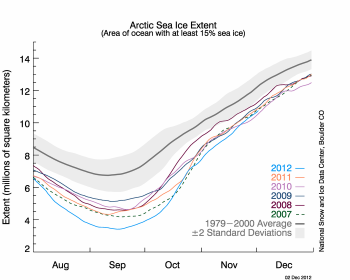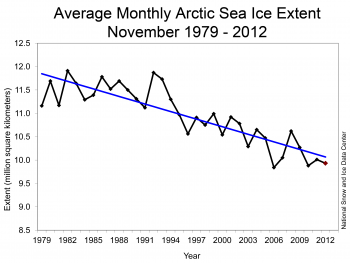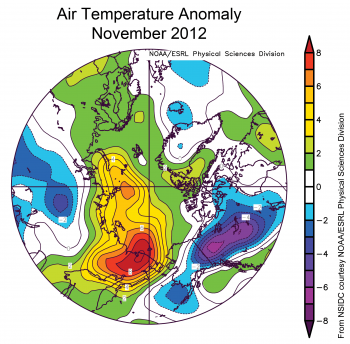Environment & Energy
Related: About this forumNSIDC - November Arctic Sea Ice Third-Lowest On Record For Month; Barents & Kara Largely Clear
November average sea ice extent was 9.93 million square kilometers (3.83 million square miles). This is 1.38 million square kilometers (533,000 square miles) below the 1979 to 2000 average for the month and is the third lowest November extent in the satellite record.
By the end of the month, the central Arctic Ocean had almost completely frozen over. However, the Barents and Kara seas remained largely ice free. Extent remained below normal in the Baffin Bay and Hudson Bay, but ice extent in the Bering Sea by the end of the month was greater than average, continuing a pattern seen in recent years. Extent in the Bering Sea was at record high levels last winter.

Figure 1. Arctic sea ice extent for November 2012 was 9.9 million square kilometers (3.8 million square miles). The magenta line shows the 1979 to 2000 median extent for that month. The black cross indicates the geographic North Pole.
Conditions In Context
Extent can increase quickly during November because there is little solar energy and the ocean is rapidly losing the heat that it gained in summer. For the Arctic as a whole, ice growth for November 2012 was faster than average, increasing at an average rate of 98,600 square kilometers (38,100 square miles) per day. After remaining lower than levels observed in 2007 for most of the month, by November 30 ice extent matched or exceeded extent seen in 2007, 2006, and 2010.

Figure 2. The graph above shows Arctic sea ice extent as of December 2, 2012, along with daily ice extent data for the previous five years. 2012 is shown in blue, 2011 in orange, 2010 in pink, 2009 in navy, 2008 in purple, and 2007 in green. The 1979 to 2000 average is in dark gray. The gray area around this average line shows the two standard deviation range of the data.
November 2012 Compared To Previous Years
Average sea ice extent for November 2012 was the third lowest in the satellite record. This marks only the third year in the satellite record that November extent was below 10 million square kilometers (3.86 million square miles). Through 2012, the linear rate of decline for November Arctic ice extent is -4.8% per decade relative to the 1979 to 2000 average.

Figure 3. Monthly November ice extent for 1979 to 2012 shows a decline of -4.8% per decade.
Air Temperatures Remain High Over Ice-free Areas
November air temperatures at the 925 hPa level (approximately 3,000 feet) were above average over most of the Arctic Ocean. Notably, temperatures in the Barents and Kara seas were up to 6 degrees Celsius (11 degrees Fahrenheit) higher than average. This reflects in part the lingering open water in the regions, allowing strong upward transfers of heat from the ocean to the atmosphere. Unusually strong winds from the south contributed to the warmth and also helped keep the region ice free.
More striking were the unusually warm conditions over the ice-covered East Siberian Sea, where temperatures were 6 degrees Celsius (11 degrees Fahrenheit) above average. This appears to be due to persistent high pressure over the Bering Strait. Southerly winds on the west side of the high-pressure zone brought warm air into the East Siberian region. Colder, northerly winds on the east side of the high-pressure zone help explain the higher-than-average extent in the Bering Sea.

Figure 4. This image shows air temperature anomalies at the 925 hPa level averaged for November 2012, compared to averages over the period 1981 to 2010. Temperatures were above average over the East Siberian, Barents, and Kara seas.
EDIT/END
http://nsidc.org/arcticseaicenews/